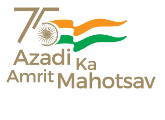NATIONAL SCIENCE DAY (28 FEBRUARY 2007)
The National Science Day was celebrated in the Institute with great enthusiasm. Nearly 200 school children participated in the programme in the morning, which included a short movie on IIA titled From Nungambakkam to Hanle, observation of the Sun and sunspots through an appropriate telescopic arrangement in a tent set up for the purpose, a continuous movie show at the Seminar Room and an exhibition of colourful posters on astronomical objects and models of our telescopes. A table-top model of the TAUVEX payload was a special attraction.The Institute wore a festive look with groups of children surrounding the scientist-volunteers at the solar tent in the lawns and at the exhibition area keeping them busy with their questions. The movie show which featured Cosmic Collisions produced by NASA's Outreach Programme and a locally produced feature on the Life and Times of Albert Einstein drew considerable crowd. Senior graduate students were at hand to explain the show.
At 11.45 AM, Jayant Murthy gave a scintillating talk on `Science from Space -- Fifty Years of Space Flight'. The year 2007 is special because it commemorates the golden jubilee of the beginning of the Space Age, which had started with the successful launch of the first artificial satellite, Sputnik I by the Soviet Union. Professor Murthy's talk touched upon all the important milestones of the last fifty years in the area of Space Sciences and the rich benefits that have accrued to Astronomy through the explorations from space. He also spoke on ISRO's plans to launch satellites for astronomical observations from space and IIA's special role in the design and operation of these payloads.
In the afternoon, we had a different set of students. These were science undergraduates from St Joseph's and Jyothi Nivas, two premier colleges of Bangalore. They too were shown the movie on IIA, then taken to the solar tent for observing the Sun and to the exhibition area. In addition, these students were taken to the Photonics Laboratory of IIA. Two slightly more technical talks, one on the Sun and IHY by Dipankar Banerjee and one on the Life and Death of Heavyweight and Lightweight Stars by Gajendra Pandey, exposed the students to some of the modern ideas and results on two important areas of astronomy.
The evening programme started at 6 PM with a talk by Ashok Pati on Introducing the Night Sky. It was a fascinating powerpoint presentation on how one goes about looking at the night sky and what one finds there. Close-up views of planets and nebulae and galaxies were shown. This prepared the assembly for the real show which started at around 7 PM on the terrace of the Main Laboratory Annexe. A 14-inch automated Meade Telescope was set up for watching the sky at night. The skies were clear and about 40 people had gathered to look through the telescope. The Moon was in its waxing phase and rather bright. Among the planets Saturn was available for viewing. Other celestial objects like the Great Nebula in Orion and the Pleiades Cluster were ideally placed for early evening viewing and they added to the beauty of the celestial show. Senior graduate students of the Institute and a few scientists were around all the time to assist the viewers.
Celebrations of the Science Day were finally brought to a close beyond 9 PM.
Watching the night sky through the Meade Telescope is going to be a regular feature of the Outreach Programme of the Institute. Please visit the IIA website to make sure you do not miss the next time the session is on.

